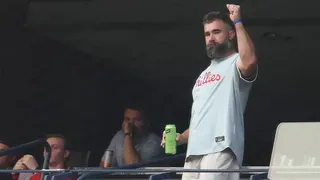November 17, 2016
Angel's Envy Distillery: Bourbon Revival Stirs in Louisville
Brunce Schreiner READ TIME: 3 MIN.
Visitors to Louisville's newest distillery raised glasses Wednesday to toast the opening of Angel's Envy in a high-profile downtown location. Tourism officials are celebrating yet another sign of bourbon's momentum in a city riding a wave of whiskey-inspired tourism.
Production of the super-premium brand is part of the industry's revival in downtown Louisville, where distilleries are being built along old Whiskey Row and bourbon's roots there date to the late 1700s.
The Angel's Envy distillery, in a century-old building that underwent massive renovations, is across the street from the city's minor-league baseball stadium, near Interstate 65. The prominent location should help build recognition for a brand created by a father-and-son team.
"You come across the bridge from Indiana on I-65, you see our building," said brand co-founder Wes Henderson.
Henderson's father, renowned master distiller Lincoln Henderson, came out of retirement to help develop Angel's Envy. Lincoln Henderson, who helped create the Woodford Reserve brand for Brown-Forman Corp., died in 2013.
"He would be so proud of what we've accomplished in such a short amount of time," Wes Henderson said.
Wes Henderson's son, Kyle, the brand's production manager, led the toast at the celebration that included local and state officials.
"To the brand, to the city of Louisville and most importantly to Wes and Lincoln Henderson," Kyle Henderson said in salute.
Sales for the brand's whiskeys have grown from about 45,000 cases in 2013 to a projected 125,000 cases this year. Part of the Bacardi Ltd. portfolio, the brand adds a different twist to its whiskeys. Its bourbon is finished in port wine barrels and its rye whiskey in rum casks.
The distillery opening offers more proof that whiskey makers are gaining a foothold in downtown Louisville.
Before Prohibition, downtown Louisville was a whiskey industry hub. Then Louisville faded as a center of the bourbon sector after Prohibition, though it remained home to distilleries for Brown-Forman and Stitzel-Weller.
The state's most famous distilleries, including Jim Beam, Wild Turkey, Maker's Mark, Four Roses and Woodford Reserve, operate in rural central Kentucky, a short drive from Louisville.
Now, Louisville is becoming a magnet for bourbon ventures.
Industry heavyweights Jim Beam and Heaven Hill Distilleries Inc. developed whiskey-related attractions downtown. Brown-Forman is developing a downtown distillery to produce Old Forester bourbon, its founding brand that has seen a sales revival. Michter's Distillery, a producer of high-end whiskeys, is converting a downtown building into a distillery. Several craft producers have opened or are planning distilleries.
"I think that downtown is going to be a real tourist destination," said Michter's President Joseph J. Magliocco.
Tourism officials see a potential akin to the popularity of the Napa Valley wine region in California.
Bourbon tourism got a boost this year when Kentucky lawmakers passed legislation allowing visitors to sip cocktails and purchase more whiskey during distillery tours. Last year, nearly 900,000 guests visited the Kentucky Bourbon Trail and Kentucky Bourbon Trail Craft Tour.
"With the continued investment of the bourbon and tourism industries, there is no question that we have the ingredients to become the next Napa," said Karen Williams, president and CEO of the Louisville Convention and Visitors Bureau.
The city's bourbon revival includes an Urban Bourbon Trail with 34 establishments promoting bourbon cocktail and culinary experiences.
Stacey Yates, a spokeswoman for the convention and visitors bureau, said the city could become home to as many as a dozen whiskey visitor experiences within a couple of years. A decade ago, bourbon tourism in the city was non-existent.
"There was no talk of bourbon in Louisville other than drinking it," she said. "There was no bourbon attraction. None on the planning boards. It was largely aspirational when we started promoting this concept of bourbon country and Louisville as this entrance point to it."




